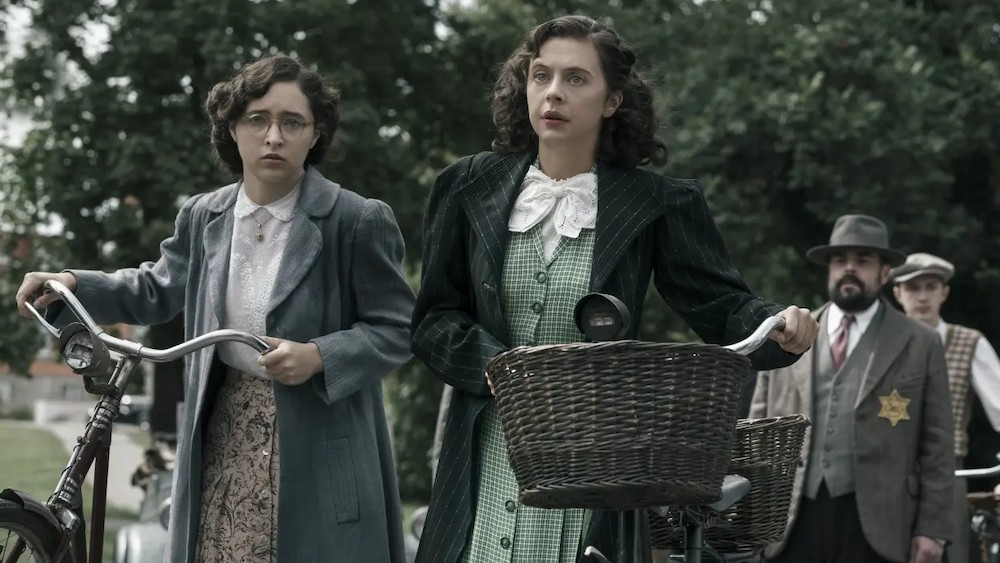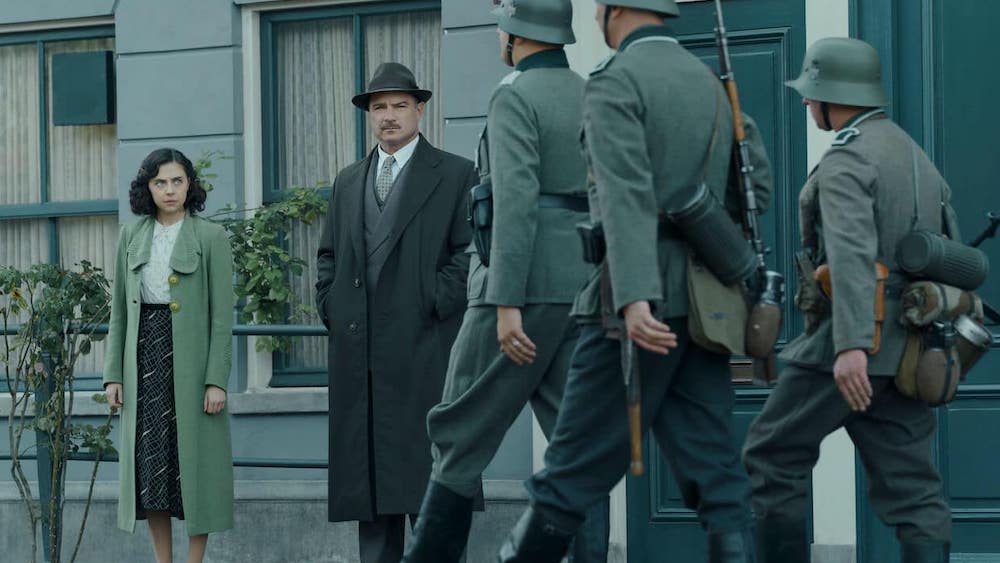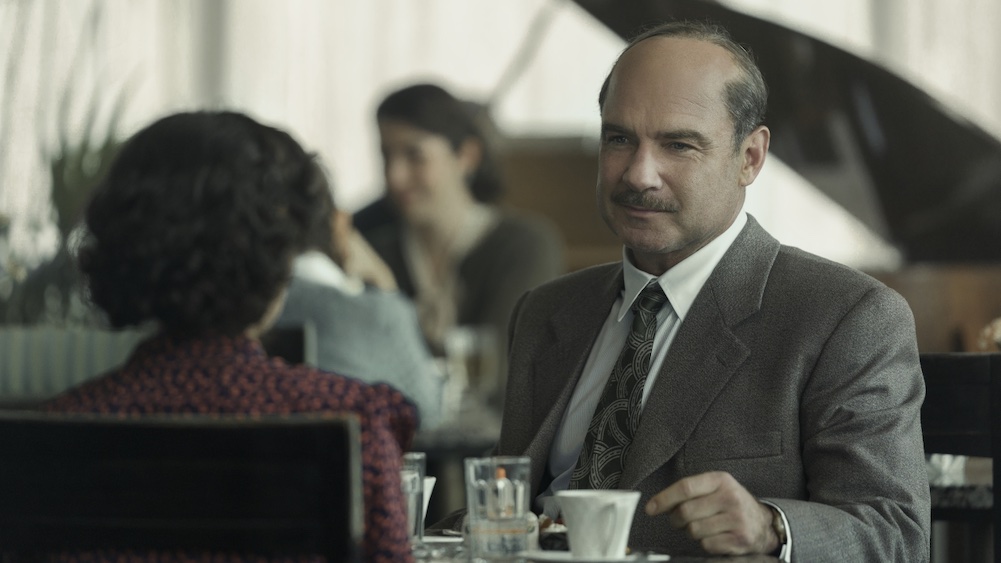
Even though she read Anne Frank’s diary when she was younger, A Small Light editor Susan E. Kim was not familiar with Miep Gies before reading the pilot. Kim, who previously worked on Little America, helped tell Gies’ story while production took place in Prague and Amsterdam, and Kim and A Small Light’s other editors were hard at work in Los Angeles.
The time differences add some challenges when it comes to communication but director Susanna Fogel always responded. Showrunners Tony Phelan and Joan Rater also offered their direction and let Kim explore with the editing. Kim also tells Below the Line about what it was like to cut the footage featuring a phenomenal Bel Powley in the role of Miep Gies.
A Small Light tells the story of Miep (Bel Powley) and Jan Gies (Joe Cole) and their efforts to protect the Frank family in Amsterdam during the Holocaust. The earlier episodes set the mood prior to the Nazis marching into the Netherlands. Tension builds as the series continues its run and audiences see the work of the Dutch Resistance on display.
Recently, Kim talked with Below-The-Line about her work on the Emmy-nominated series.
Below-the-Line: I found A Small Light to be a very well-made limited series about Miep Gies and efforts to protect the Frank family during the Holocaust. What did you know about Miep Gies going into working on the series?
Kim: Thank you! I admit that I didn’t know about Miep Gies until I read the Pilot script. I’d read Anne Frank’s diary when I was a kid and had forgotten so much. It was meaningful to learn about Miep’s story. It was also humbling — a reminder about how important it is to keep peeling back the layers of history.
BTL: How did you first become attached to working on A Small Light?
Kim: I was connected to the show through my agent. When I read the Pilot script, I was blown away. Even on the page, it felt like this completely fresh perspective — a total page turner.
I had a meeting with Tony Phelan, Susanna Fogel and the post producer, Katie O’Hara. This just solidified what I was picking up from the script. Tony and Joan Rater, our showrunners, envisioned this show with a modern sensibility. They didn’t want a dusty historical war show.
Before I read the script, I had these preconceptions about what a show involving the Holocaust might look and feel like. I could tell from the script and from talking with Tony and Susanna, in that first meeting, that this was something special. Not to mention, it felt so important to tell this story, which motivated me as well.
It’s funny, now I think my preconceptions mirror the way that some viewers might approach the show. For example, people have told me they had all these ideas about what the show is. But then they actually watch it, they’re surprised by the unique voice of the show, and they love how engaging and tonally complex it is.
BTL: Did you visit the Anne Frank House at any point before or during production?
Kim: I wish. I have not been to Amsterdam yet. I’m excited to go and would very much like to visit the Anne Frank House. I know it’d be a powerful and moving experience.
Production did such an excellent job recreating the hiding place of the Annex. I know they had to be mindful of making it an accurately claustrophobic space that was also a usable set.
The show adds to our understanding of Anne Frank’s story because it’s told through the privileged perspective of Miep and Jan Gies. During the war, they were still out in the world, trying to live their lives. So it was about this juxtaposition of the Annex and everything outside of it. You really see and feel this contrast in the show. Our production designer, Marc Homes, was masterful, with all the thoughtful details that were included.
BTL: The pilot is such an important episode with introducing viewers to Miep Gies and setting the tone for the series. How closely were you working with Susanna Fogel and the showrunners during the editing process?
Kim: It’s true, the Pilot does feel like a big responsibility. You want to establish the tone and style of the show and honor the showrunners’ vision for it. Some of my cues came from Tony, in our first conversations. There were music ideas, for example, that he mentioned early on, such as “Tin Hat Trio.” That’s one of the needle drops that I edited into the jam-making sequence in the Pilot episode. It worked so well that it just stuck. It was also sonically harmonious with Ariel Marx’s gorgeous score, which is now Emmy-nominated. Go Ariel!
Production was in Prague and Amsterdam and the editors were all cutting in Los Angeles. So you have to read the room, so to speak, but it’s in this remote way. The communication with Susanna was great. She always let me know she was there. Sometimes, she’d text about certain details and share her intentions for shots or scenes. I tried not to inundate her with messages, given the time differences and knowing how much production was dealing with.
When we got into the later parts of the editing process, there was a lot more contact. You’re communicating with the team on most days. The pace on a show like this can keep you on your toes. At one point, I had three episodes in play, which means a lot of shifting gears. All of this was done remotely over Evercast.
As showrunners, Tony and Joan are very trusting of their team. They’re not ones to micromanage. If there was something we needed to explore, they’d offer the direction and let me dive in and see what solutions I could come up with. I’d share my work, we’d discuss, and adjust.
As directors, I was so impressed with Susanna and Tony. Their filmmaking is so intentional and clear – they both had a deep understanding of the pieces that were needed. You can really see a plan for how things connect in the dailies. It’s a beautiful way to work.
Overall, this experience was a great reminder about how confident artists maneuver through the creative process. If something worked, neither Tony nor Joan nor Susanna felt the need to keep turning the same stone over and over. They felt the conviction of it and moved on to the next step. Collaboration and strong creative leadership! I loved it.

BTL:In editing the first, third, and sixth episodes, were there any sequences that you found to be the most challenging from an editor’s standpoint?
Kim: We experimented with the structure of the Pilot episode. Originally, it had us shifting between the past and the present. The “past” was Miep’s backstory — how she went from being this carefree young woman to becoming this brave person who put her life at risk to do the right thing. The “present” was Miep and Margot’s bike ride to get to the hiding place.
Rather than intercutting, Joan suggested we try combining all of the past, so we follow Miep on this linear arc through most of the episode. Eventually the past collides with the present, but it’s this very clear way of moving through time.
The question was what do to with the bike ride that starts off the episode. I ended up simplifying the bike ride into its most essential, urgent and scariest parts. We also wanted the scene at the bridge to be the dramatic trigger that would get us into Miep’s past. It was tricky to figure out the right amount of emotional pause here in order to accomplish this.
I ended up reappropriating footage from a couple scenes. Joan helped me write, with ADR, a slightly altered conversation between Miep and Margot, so all of the pieces flowed together.
Some people may not realize it, but this experimentation is a good example of how much can happen during the editing process. It can be a big undertaking but it’s so rewarding when it works. I had such great time taking on the challenge of the Pilot.
BTL: Bel Powley is so phenomenal in the series. What was it like being able to sort through the footage of her in the editing room?
Kim: Bel Powley is amazing. It was a joy to work with her scenes. She always managed to give options that I could use in the editing room, without ever compromising her craft.
The role of Miep required Bel to constantly shift gears. One moment she’s making a witty joke to Jan, played by the extraordinary Joe Cole, and the next minute there’s a Nazi at the door. Bel needed to make those big transitions and carry the gravity of the every situation.
As an editor, you’re reviewing the footage and performances so that you can build a scene in which all that shifting, and all those transitions, track – they need to make sense and feel believable. When you’re working with actors of this caliber, they give you everything you need to make it work. You can follow them nanosecond to nanosecond on screen, as their characters play out the situation they’re in.
The show definitely goes to both joyful and heavy places and there’s so much tonal complexity. It takes an actor of great skill to carry this range and make it seem so effortless. I truly hope Bel and the entire cast are recognized for their work here.
BTL: Was there ever a moment where it just got too emotionally heavy and you had to break away from the screen?
Kim: I admit I have to step away from the screen after I work on any dramatic material. So I’ll watch all the dailies, take my notes and pull selects. I’ll take a break, maybe work on something else. Then, I’ll come back and assemble. You do this because you have to stay fresh. As an editor, you’re constantly absorbing and processing so much information.
Filmmaking feels like this enormous vehicle. It’s like you’re riding in this giant empathy machine and it’s imperative that you show up and stay in this openminded and generous space. Otherwise, you stop seeing things. I really care for the people that I’m editing, both the characters and the actors. I want to make sure the work represents the amount of heart that is brought to it. So, I take breaks, but it’s also just a part of my process.

BTL: How did you first get an interest in becoming an editor?
Kim: I took my first editing class in high school. This eventually led to studying filmmaking in college and grad school. The editing room was always the place that I gravitated towards. I found early on that I had a temperament for it. I’d get absorbed in the work all day and lose track of time.
I was really into experimental filmmaking when I started out — work by filmmakers like Sadie Benning, who would tell these innovative stories on a pixel vision camera in her bedroom, or Deborah Stratman, who would make these thoughtful essays that sometimes dealt with topical issues, but also resonated like poems for me. The possibility of what film could do really cracked open for me.
From studying and trying my hand at experimental filmmaking, I learned early on the power of editing to rewrite and shape material. It’s skillset that I’ve definitely leaned on as an editor.
BTL: Is there an editing program that you prefer using?
Kim: Avid Media Composer.
BTL: Survivors are continually dying the further we get from the Holocaust and education is not at the level where it should be. What do you hope audiences take away from watching the series?
Kim: This is such an important question, thank you for asking it. My hope is that audiences continue to understand what happened during the Holocaust. That the learning never stops. There’s been a rise in antisemitism and it’s urgent that we know this and not repeat history. It’s telling that as we were making this show, a certain celebrity with a huge platform was making blatant antisemitic remarks.
Also, I hope people can understand what it means to be an ally to a group of people who are being targeted with such extreme violence. How do we actually stand up for what’s right, in order to prevent this?
On a personal note, as I worked on the show, I was also thinking about different kinds of violence in our communities, whenever any group is targeted for being who they are. I was thinking about my elderly Asian parents and remember being worried for them, especially during the pandemic. I hope that there would be a Miep who would stand up for them. I believe a show like this can help people to connect the dots and take action.
Finally, I hope that viewers will be inspired by Miep Gies’ story, no matter who they are. I love Miep’s message. She said that “even an ordinary secretary” can “turn on a small light in a dark room.” This is the now famous quote from which our show gets its name. This reminder is so moving to me.
All episodes of A Small Light are currently streaming on Disney+ and Hulu.





